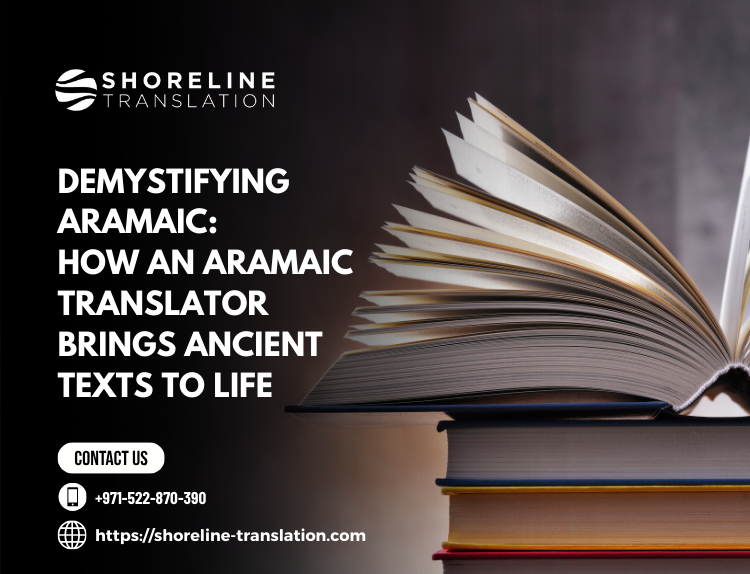Table of Contents
ToggleDemystifying Aramaic: How an Aramaic Translator Brings Ancient Texts to Life
Unraveling the mysteries of ancient civilizations has always been a captivating endeavor. And at the heart of these enigmatic cultures lies a language that holds profound secrets: Aramaic. This ancient Semitic language, once spoken by Jesus himself, has long fascinated scholars and history buffs alike. But how do we bridge the gap between this centuries-old tongue and our modern world?
The answer lies in the skilled hands of an Aramaic translator! In this blog post, we will demystify the world of Aramaic translation and explore how these linguistic sleuths bring ancient texts to life with their unrivaled expertise. So grab your magnifying glass as we embark on a journey through time with these remarkable language experts!

Role of an Aramaic Translator
Have you ever wondered how ancient texts written in Aramaic are brought to life for modern readers? Enter the role of an Aramaic translator, a linguistic wizard who possesses the incredible ability to decode and interpret this ancient language.
The primary role of an Aramaic translator is to bridge the gap between the past and the present. They act as cultural intermediaries, unlocking the secrets hidden within these ancient texts and making them accessible to contemporary readers. Their expertise lies not only in understanding the grammar and vocabulary of Aramaic but also in comprehending its historical context.
To accomplish this formidable task, Aramaic translators undergo years of rigorous training. They immerse themselves in linguistic research, studying various dialects and deciphering complex scripts. Armed with their knowledge, they meticulously analyze each word, sentence, and passage before crafting a faithful translation that captures both the literal meaning and nuanced subtext.
However, being an Aramaic translator comes with its fair share of challenges. The scarcity of available source materials often poses difficulties in accurately interpreting certain phrases or idioms unique to ancient times. Additionally, different variations of the language can make it challenging to identify precise meanings or translations without extensive study.
Yet despite these hurdles, skilled translators employ several techniques to ensure accurate translations. They consult reference materials such as dictionaries and grammatical guides specifically tailored for Aramaic studies. Moreover, they collaborate with experts from related fields like history or archaeology to gain deeper insights into cultural references found within texts.
In conclusion, an Aramaic translator plays a crucial role in bringing ancient texts back to life by unraveling their mysteries through careful analysis and interpretation. Their expertise allows us to delve into rich historical narratives while preserving our collective heritage for future generations
Challenges Faced by Aramaic Translators
Aramaic, is the ancient language that has captivated scholars and historians for centuries. As beautiful as it is complex, Aramaic poses many challenges for translators seeking to bring its texts to life in the modern era.
First and foremost, Aramaic is a Semitic language with numerous dialects. This diversity can make it difficult for translators to determine which specific dialect they’re working with or which variant of a word or phrase should be used.
Another challenge lies in the lack of standardized spelling and grammar rules in ancient Aramaic texts. Translators may encounter inconsistencies or variations in how words are spelled or sentences are structured, requiring careful analysis and interpretation.
Furthermore, translating Aramaic involves deciphering scripts that have aged over millennia. The deterioration of manuscripts can result in missing fragments or illegible sections, making it challenging for translators to piece together a coherent translation.
Context plays a crucial role in understanding and accurately translating Aramaic texts. Without proper contextual knowledge of historical events, cultural practices, and linguistic nuances from the period when these texts were written, translations may lose their intended meaning.
Overcoming these challenges requires expertise and dedication from an experienced Aramaic translator who possesses not only linguistic skills but also deep knowledge of relevant historical contexts.
By navigating through uncertainties with meticulous attention to detail and extensive research efforts, these professionals ensure accurate interpretations that breathe new life into ancient writings—preserving our collective history for generations to come!
Techniques Used by Aramaic Translators
1. Deciphering the Script: Aramaic translators possess a deep understanding of the ancient script, enabling them to decipher and interpret the characters accurately. They meticulously analyze each symbol’s meaning, taking into account its context within the text. This attention to detail ensures an accurate translation that captures the nuances of the original message.
2. Contextual Analysis: Beyond just translating individual words or phrases, Aramaic translators delve into the historical and cultural contexts surrounding a text. By studying contemporary literature, customs, and practices from that era, they gain valuable insights into how certain words or phrases were used at that time. This contextual analysis allows for a more comprehensive understanding of the text’s intended meaning.
3. Comparative Linguistics: Aramaic translators often rely on their knowledge of related languages such as Hebrew and Arabic to aid in their translations. These languages share common roots with Aramaic and offer valuable comparative insight when dealing with ambiguous or obscure terms. Drawing parallels between these languages helps fill gaps in understanding and enhances accuracy.
4. Textual Criticism: To ensure fidelity to ancient texts, Aramaic translators engage in textual criticism techniques like collation and emendation. Collation involves comparing different versions of a text across manuscripts to identify discrepancies or variations in wording—an essential step towards achieving an accurate translation free from errors or omissions.
By employing these sophisticated techniques, Aramaic translators breathe life back into ancient texts. They safeguard our heritage, capturing not only mere words but also preserving the rich tapestry of history, culture, and knowledge contained within each text. Through
Importance of Accurate Translation in Preserving Ancient Texts
When it comes to preserving ancient texts, accurate translation is of utmost importance. It allows us to unlock the rich history and knowledge hidden within these ancient writings. Here are five reasons why accurate translation plays a vital role in safeguarding these precious texts:
1. Preserving Cultural Heritage: Ancient texts provide valuable insights into the beliefs, customs, and traditions of civilizations long gone. Accurate translation ensures that this cultural heritage is not lost but instead passed down through generations.
2. Retaining Historical Accuracy: Ancient texts often contain historical events and details that shape our understanding of the past. By translating them accurately, we can retain their historical accuracy and enrich our knowledge of bygone eras.
3. Facilitating Academic Research: Scholars rely on accurate translations to conduct in-depth research on various subjects such as linguistics, religion, philosophy, or literature. A precise translation enables scholars to analyze and interpret these texts with confidence.
4. Enhancing Cross-Cultural Exchange: Accurate translations promote cross-cultural exchange by allowing people from different backgrounds to access and appreciate ancient works from diverse cultures worldwide.
5. Uncovering Lost Wisdom: Many ancient texts hold valuable wisdom that can still be relevant today if properly understood through accurate translation. This enables us to learn from the wisdom of our ancestors and apply it to contemporary challenges.
Accurate translation serves as a bridge between past civilizations and present-day society by preserving cultural heritage, retaining historical accuracy, facilitating academic research, enhancing cross-cultural exchange, and uncovering lost wisdom contained within ancient texts
Impact and Legacy of Aramaic on Modern Languages
Aramaic, with its rich history and ancient roots, has left an indelible mark on modern languages. This Semitic language, spoken by Jesus Christ himself, continues to influence our linguistic landscape in ways we may not even realize. Let’s explore the impact and legacy of Aramaic on today’s languages.
In terms of vocabulary, Aramaic has contributed numerous words that have found their way into various modern languages. From common everyday words like “mammon” (meaning wealth) to religious terms like “amen” (meaning so be it), the influence of Aramaic is widespread.
Furthermore, Aramaic grammar and syntax have also influenced other languages. For instance, the structure of sentences in Arabic bears a striking resemblance to that of Aramaic. The use of pronouns and verb conjugations are similar as well.
The impact doesn’t stop there – many place names around the world can be traced back to their origins in Aramaic. Cities such as Damascus and Bethlehem derive their names from this ancient language, serving as reminders of its enduring legacy.
Beyond language itself, understanding Ancient Aramaic texts provides valuable insights into history and culture. Translations allow us to delve deep into biblical texts or discover lost writings from ancient civilizations. Preserving this knowledge is crucial for future generations.
In conclusion, the impact of Aramaic on modern languages is undeniable. Its vocabulary, grammar, and syntax have influenced numerous languages, and its legacy can be seen in the everyday words we use and the places we visit. As a language that has stood the test of time, Aramaic serves as a bridge connecting us to our past and enriching our present.
Shoreline now offers an Aramaic translator for all texts
Shoreline now offers an Aramaic translator for all texts! Yes, you heard it right! This incredible service brings the ancient language of Aramaic to life in a once unimaginable way. Whether you need to translate ancient manuscripts, religious texts, or even personal documents, Shoreline’s team of expert translators can help you unlock the secrets hidden within these ancient writings.
With their extensive knowledge and expertise in Aramaic, Shoreline’s translators are equipped to tackle even the most challenging texts. They understand the nuances and intricacies of this ancient language, allowing them to accurately convey the true meaning behind each word and phrase. The dedication and passion they bring to their work ensure that every translation is done with utmost precision.
But what sets Shoreline apart from other translation services? It’s their commitment to using cutting-edge techniques and technologies that truly make a difference. From linguistic analysis tools to specialized dictionaries, these translators utilize a variety of resources to ensure accuracy and authenticity in every translation.
By offering an Aramaic translator for all texts, Shoreline is not only preserving our rich cultural heritage but also providing a gateway to understanding our past. These translations allow us to uncover new insights into history, religion, and literature – truly broadening our horizons as individuals and as a society.
So whether you’re embarking on an academic journey or simply curious about the mysteries of Aramaic yourself, look no further than Shoreline’s professional translation services. Let them bring these ancient texts back to life so we can continue learning from our collective human history!
FAQs
1. What is Aramaic?
Aramaic is an ancient Semitic language that originated in the Near East around 1200 BCE. It was widely spoken during various periods in history, including the time of Jesus Christ. Today, it is considered a sacred language by many religious communities.
2. What does an Aramaic translator do?
An Aramaic translator specializes in converting texts written in Aramaic into modern languages or vice versa. They possess deep knowledge of both ancient and contemporary linguistic structures, enabling them to accurately convey the meaning and nuances of these historical texts.
3. Are there any challenges faced by Aramaic translators?
Absolutely! One major challenge lies in deciphering ancient manuscripts that may be damaged or incomplete. Furthermore, since there are several dialects within the Aramaic language family, translators must be well-versed in each variation to ensure accurate translation.
4. How do Aramaic translators tackle these challenges?
To overcome difficulties posed by damaged manuscripts, they employ advanced techniques such as paleography and textual criticism to piece together missing information from similar sources.
Additionally, extensive research and collaboration with scholars help unravel complex grammatical structures unique to different dialects and ensure precise translations.
Conclusion
As we conclude our exploration of Aramaic and the invaluable role of an Aramaic translator, it becomes evident that this ancient language holds a richness and significance that transcends time. With its roots deeply embedded in history and its influence extending to modern languages, Aramaic continues to captivate scholars, historians, and linguists alike.
The arduous task faced by Aramaic translators cannot be underestimated. They are not merely deciphering words but breathing life into texts that have weathered the ages. Their meticulous work ensures that these ancient manuscripts are preserved for future generations to study and appreciate.
Through their expertise, dedication, and utilization of various techniques such as comparative analysis, contextual understanding, linguistic knowledge, historical research, and collaboration with experts from diverse fields – these skilled professionals bring forth the hidden treasures within Aramaic texts.
Accurate translation is paramount when it comes to preserving the authenticity and integrity of ancient texts. A nuanced understanding of grammar nuances allows translators to capture the true essence of each word or phrase while maintaining readability for contemporary readers.
The impact of Aramaic on modern languages cannot be understated either. It has left an indelible mark on numerous dialects across different regions around the world. From loanwords in Arabic to influences on Hebrew syntax; even certain phrases used today trace back their origins to this fascinating language.
At Shoreline Translation Services, we recognize the importance of accurate translation in bridging gaps between cultures and preserving heritage. That is why we proudly offer our professional Aramaic translation services for all your needs – whether you’re working with ancient manuscripts or require assistance with more contemporary documents.
In conclusion, through our dedicated team of experienced translators well-versed in both classical and modern forms of this enigmatic language; we aim to revive ancient texts while enabling access for a wider audience who seek insight into history’s rich tapestry woven through words written long ago.

